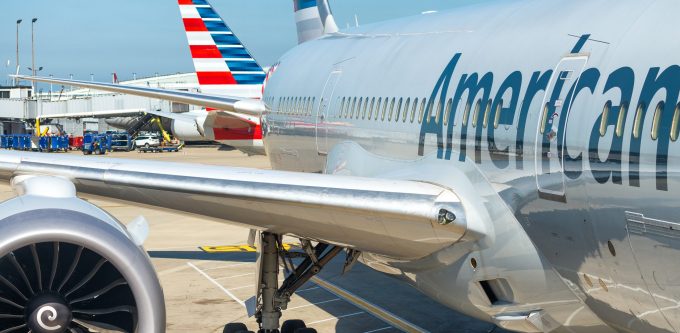Big Three US airline cargo revenues continue to shrink alongside margins and rates
Unveiling its numbers yesterday, American Airlines was the last of the Big Three US passenger ...
TFII: SOLID AS USUALMAERSK: WEAKENINGF: FALLING OFF A CLIFFAAPL: 'BOTTLENECK IN MAINLAND CHINA'AAPL: CHINA TRENDSDHL: GROWTH CAPEXR: ANOTHER SOLID DELIVERYMFT: HERE COMES THE FALLDSV: LOOK AT SCHENKER PERFORMANCEUPS: A WAVE OF DOWNGRADES DSV: BARGAIN BINKNX: EARNINGS OUTODFL: RISING AND FALLING AND THEN RISING
TFII: SOLID AS USUALMAERSK: WEAKENINGF: FALLING OFF A CLIFFAAPL: 'BOTTLENECK IN MAINLAND CHINA'AAPL: CHINA TRENDSDHL: GROWTH CAPEXR: ANOTHER SOLID DELIVERYMFT: HERE COMES THE FALLDSV: LOOK AT SCHENKER PERFORMANCEUPS: A WAVE OF DOWNGRADES DSV: BARGAIN BINKNX: EARNINGS OUTODFL: RISING AND FALLING AND THEN RISING

American Airlines is flying into the summer season schedule with ‘one hand tied behind its back’, but its cargo division has morphed into a new configuration geared to take advantage of new tools and opportunities.
The airline is adding to its international network with a service between New York and Doha and resuming services between Charlotte and Rome.
It is also beefing up international capacity with the shift of all widebodies currently operating on shorthaul routes in the Caribbean, Latin America and Mexico to transatlantic routes, including Barcelona, Lisbon and Venice.
However, American is short of aircraft to resume flights to European destinations it used to serve with A330, B767 and B757s. All these have been axed from the fleet. On some routes the carrier has fielded B787s, but delivery of 787s has been hit by production delays at Boeing and there is no replacement for the 757 until the arrival of A321XLRs, due next year.
The rising need for widebody passenger capacity is curbing the elbow room for cargo-only flights, which have already shrunk over past months as domestic passenger traffic recovered.
During the early stages of the pandemic, the threshold for the viability of cargo flights was whether they could cover costs and where customers needed them, said Jessica Tyler, president of cargo and VP of operations innovation and delivery. The threshold rose when American had a choice between flying a widebody three times a day between Dallas and Cancun and one daily cargo flight, she added.
The airline has carried out over 10,000 cargo flights and their contribution had been “phenomenal”, she said. In the fourth quarter, cargo revenues were up 57.9% to $341m, with full-year revenue up about 100% to $1.3bn.
American is not done with cargo flights yet, though. They are still in play on some sectors, primarily to Asia.
Ms Tyler is bullish on the outlook: passenger bookings have begun to rise again and the cargo market looks set to continue to show an imbalance between supply and demand, she said.
“We’ve got plans, we’ve got an outlook, but we’ve learned that things can change rapidly,” she added.
One cause for optimism is the cargo division’s ability to respond to sudden changes in a significantly faster way. A major factor is the carrier’s iCargo platform, which replaced a patchwork of legacy systems, enabling the various data to be connected. This informed more solid decision-making, for instance in the assessment of the viability of cargo flights.
Ms Tyler sees the use of the platform still at an early stage, offering opportunities for improvement to automate functions in order to support staff.
One recent example is the capability to do online bookings for complex shipments, such as live animals. Before, this would take eight to ten contacts to finalise an animal shipment, but this has been translated into self-service tools – both for the customer to book online and for AA Cargo staff to service that shipment.
“It really shifts their focus from the tactical things to more ‘how can I take care of you in a moment, Mr and Ms Customer’,” she said.
She is also looking at online booking platforms “to make sure our products and services can be found wherever our customers are shopping or getting themselves organised”.
The use of artificial intelligence is another major focus. The team that works on this (going back to pre-iCargo days) is tasked with automating processes as well as leveraging predictive analytics for aspects like booking and capacity and putting technology into actual use cases.
The cargo organisation underwent a restructure last autumn to align it better with the way management intends to work in the future. Among other changes this involved the rebuilding of a customer experience organisation to ensure that the company consistently delivers on its promises, that decisions are informed with customers in mind and to make sure that the teams are adequately equipped to deliver to customers.
It is one of several groups that cut across the organisation to keep the focus on overarching objectives. The customer insights team, which is part of the strategy group is designed as an “objective analytical focus group looking across the organisation to drive how those insights shape our strategy and our insights going forward”.
“That was a very deliberate, strategic re-organisation,” said Ms Tyler. “We felt strongly late third quarter that we were ready to double down and make sure we were going to start working differently.
“It was a shift from survival mode to making sure the organisation was set up sustainably for the future. This involves being crystal-clear about focus areas and making sure the company has the talent lined up to tackle the future and leaders who are ready to support that talent in a period when the world of work is changing a lot, she said.
Comment on this article